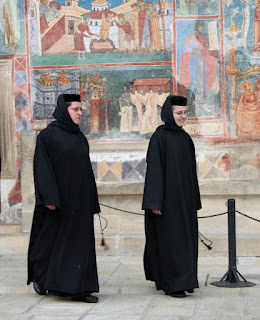We had heard a lot about the splendid renovation (2008 –
2010) by architect Postel
The museum is one of the oldest museums in the Netherlands
So arriving at the museum after our train trip and seeing
the inviting restaurant, we decided to start the day with coffee and a
pastry. Sitting in the conservatory it
is as if you are sitting outside… but you are not. The restaurant area consists
of different spaces and is also a meeting place for cultural activities.
If you have been in the Amsterdam Hermitage then you might
notice that the interior design is done by the same designers Merxx and Girot. Their find for this museum are the “jewel boxes” high legged
cupboards that contain drawings and prints on paper. You pull a drawer and
there is another “jewel” to be admired.
Apart from the beautiful building ...................
................................. there is a good collection of Dutch paintings from over a period of
400 years. The city of Dordrecht
 |
| part of a wooden frame once belonging to the Wine guild |
Rich citizens
donated money or collections to the museum. There are works of The Hague School
and Amsterdam Impressionists. The collection has two main focus points: the 19th
century and the 17th century.
Very special is the large collection of painting from AryScheffer who was born in Dordrecht and later
lived in Paris
We spend a good part of the day looking at the different
paintings, drawings, statues etc.
Here just some items….
“The Amsterdam Lauriergracht in winter” By George Hendrik
Breitner 1857-1923
(The Hague School
And this painting of a dead hare by Joris Ponse (1723-1783).
This fly won’t go off (I almost tried) … it is very life like!
“View of the Oude Maas at Dordrecht
A favourite of the public.
The weather was nice, so we did a quick tour of Dordrecht. Yes we need more time to visit Dordrecht. The city deserves it. Maybe a next time....








































